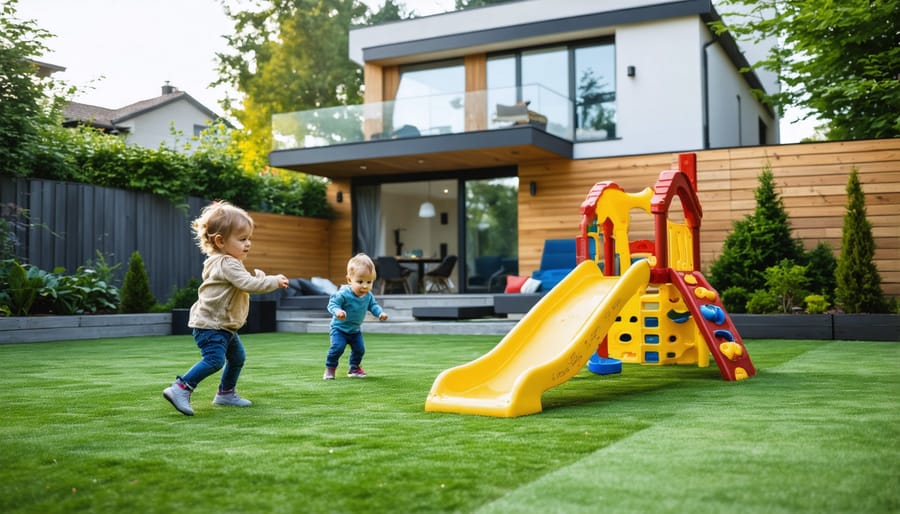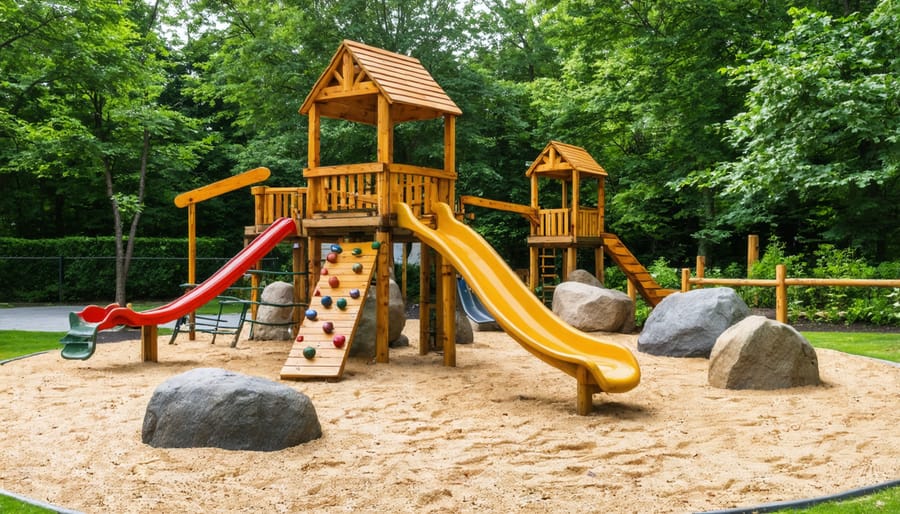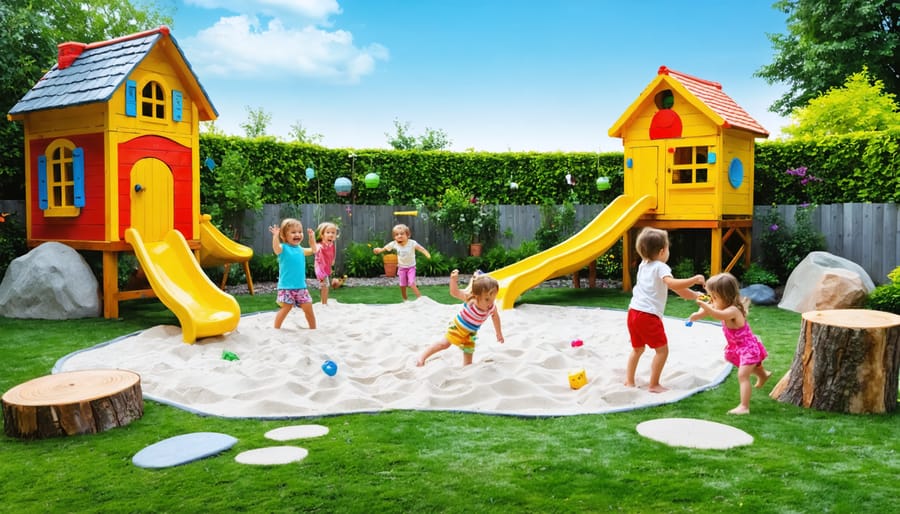Transform your backyard into a vibrant childhood paradise through strategic backyard play area creation. Designate distinct zones for active play, creative exploration, and quiet activities to maximize engagement while maintaining safety. Incorporate natural elements like climbing logs, stepping stones, and sand areas to stimulate sensory development and physical activity. Install weather-resistant storage solutions that double as play features, keeping toys organized while preserving your yard’s aesthetic appeal. Select low-maintenance, child-safe materials that withstand weather extremes and regular use, ensuring your outdoor play space remains both functional and inviting throughout the seasons. Consider vertical elements like climbing walls or playhouses that maximize limited space while providing multiple play opportunities.
Safe and Sturdy Foundation Options
Ground Coverage Solutions
When you prepare your outdoor space for a play area, choosing the right ground coverage is crucial for both safety and aesthetics. Rubber mulch offers excellent shock absorption and longevity, making it ideal for areas beneath swings and climbing equipment. While initially more expensive than traditional options, it requires minimal maintenance and doesn’t decompose like organic materials.
Wood chips provide a natural look and good impact absorption at a lower cost. They need regular replenishment but offer excellent drainage and are environmentally friendly. However, they can attract insects and may require more frequent maintenance to maintain proper depth for safety.
Artificial grass has become increasingly popular for play areas, offering year-round green space without maintenance headaches. It provides a clean, consistent surface that’s perfect for crawling toddlers and general play. While the upfront cost is higher, its durability and low maintenance requirements make it cost-effective over time. The only drawbacks are potential heat retention during summer months and the need for occasional brushing to maintain its appearance.

Proper Drainage Solutions
Proper drainage is essential for any outdoor play area to ensure safe, year-round enjoyment. Start by grading the ground with a slight slope (about 1-2%) away from play equipment and your home’s foundation. This natural gradient helps water flow away from the play space naturally.
Install a French drain system around the perimeter of your play area by digging a trench, laying perforated pipe wrapped in landscape fabric, and filling it with gravel. This underground solution efficiently channels water away from the play space while remaining hidden from view.
Consider using permeable materials for ground cover, such as rubber mulch or engineered wood fiber, which allow water to seep through while providing excellent fall protection. For paved areas, opt for permeable pavers or install strip drains along the edges to collect runoff.
During installation, create small swales or shallow drainage ditches disguised as decorative elements using river rocks or plants. These not only manage water flow but also add visual interest to your play area. Remember to regularly check and clean drainage systems, especially after storms, to prevent clogs and ensure optimal performance.

Age-Appropriate Play Zones
Toddler-Friendly Spaces
Creating a safe and engaging space for toddlers requires careful strategic play area design that caters to their developmental needs while ensuring maximum safety. Start with a soft, impact-absorbing ground surface like rubber mulch or artificial grass to cushion potential falls. Install low-height climbing structures and slides that don’t exceed 3 feet in height, allowing little ones to build confidence while minimizing risk.
Incorporate sensory play stations with water tables, sandbox areas, and textured walking paths using materials like smooth river rocks and artificial grass patches. These elements help develop motor skills and spatial awareness while keeping toddlers engaged. Consider adding musical elements like outdoor xylophones or drums mounted at toddler height for creative expression.
Create defined play zones using bright, non-toxic paint or rubber borders to help toddlers understand boundaries. Include small playhouses or reading nooks where children can engage in imaginative play while staying protected from direct sunlight. Add child-sized seating areas and tables for craft activities or snack times.
Remember to maintain clear sightlines throughout the play area so you can easily supervise activities. Keep all equipment well-maintained and regularly inspect for any loose parts or wear. Installing proper drainage systems around water play areas and maintaining clean, dry surfaces will ensure the space remains safe and enjoyable year-round.
Adventure Zones for Older Kids
For older kids who crave excitement and physical challenges, creating an adventure zone transforms your backyard into an engaging recreational space. Start with a multi-level climbing structure that features various climbing walls, cargo nets, and monkey bars to develop upper body strength and coordination. Add rope bridges and balance beams at different heights to create challenging paths between platforms.
An obstacle course adds endless possibilities for active play and fitness. Include elements like tire runs, crawl tunnels, and weaving poles that can be rearranged to create new challenges. Consider installing a ninja warrior-style course with hanging rings, climbing ropes, and suspended stepping stones that can be adjusted as kids develop their skills.
For additional adventure elements, incorporate a zip line with proper safety features and adequate landing zones. A rock climbing wall with varying difficulty levels keeps older kids engaged while building strength and problem-solving skills. Add strategic lighting for supervised evening play sessions.
Make the space versatile by including a designated parkour area with sturdy platforms at different heights and distances. Install weather-resistant exercise equipment like pull-up bars and parallel bars that both kids and adults can use. Remember to maintain adequate safety surfacing beneath all climbing elements and ensure proper spacing between equipment to prevent collisions during active play.
Storage Solutions for Play Equipment
Multi-Purpose Play Sheds
Looking to maximize your outdoor space? Consider how you can transform storage sheds into playhouses that serve double duty. These versatile structures offer the perfect solution for families seeking both play space and storage functionality. By incorporating built-in shelving, toy boxes, and creative organization systems, you can create a dedicated play area while maintaining a clutter-free yard.
Start by selecting a sturdy shed with adequate ventilation and natural light. Add child-friendly features like rounded corners, non-slip flooring, and safety latches. Paint the interior and exterior in bright, inviting colors, and consider creating themed zones within the space. One corner might house dress-up clothes and mirrors, while another could feature art supplies and a fold-down craft table.
The beauty of multi-purpose play sheds lies in their adaptability. Install wall-mounted storage bins for toys, hooks for costumes, and overhead shelving for seasonal items. Weather-resistant outdoor toys can be tucked away neatly when not in use, while indoor activities remain protected from the elements. Many families find that these converted spaces grow with their children, easily transitioning from toddler playhouses to tween hangout spots as needs change.
Weather-Protected Equipment Storage
Protecting outdoor play equipment from harsh weather is essential for longevity and safety. A well-designed storage solution keeps toys organized while shielding them from rain, sun damage, and seasonal elements. Consider installing a weather-resistant deck box for smaller items like balls, jump ropes, and sandbox toys. These boxes are perfect for quick cleanup and feature child-safe hinges for worry-free access.
For larger equipment, a dedicated storage shed provides comprehensive protection. Look for models with proper ventilation to prevent moisture buildup and mold growth. Position your storage unit on level ground, slightly elevated with a solid foundation to prevent water seepage. Many modern sheds come in attractive designs that complement your backyard aesthetic while offering ample space for bikes, sports equipment, and seasonal items.
Create an easy-to-follow organization system using labeled bins or wall-mounted hooks. This encourages children to participate in cleanup while teaching responsibility. For added convenience, install motion-sensor lighting near the storage area for safe access during early evening play sessions.
Weather-resistant canvas covers work well for permanently installed equipment like swing sets or climbing frames during extended periods of non-use or severe weather conditions. These covers are affordable, easy to install, and provide essential protection against UV damage and rust formation.
Natural Play Elements

Garden Play Spaces
Transform a portion of your yard into an educational wonderland by creating dedicated garden play spaces. Start with a child-sized garden plot where little ones can plant, tend, and harvest their own vegetables and flowers. Install raised beds at different heights to accommodate various age groups, and include child-safe gardening tools stored in weatherproof containers.
Create nature exploration zones by incorporating sensory elements like herb gardens with fragrant plants such as lavender, mint, and rosemary. Add a weather station with a simple rain gauge and wind chimes to teach children about climate patterns. Include a bug hotel or butterfly garden to encourage wildlife observation and learning about ecosystems.
Consider adding a mud kitchen with old pots and pans where children can engage in imaginative play while connecting with nature. Install small water features or rain collection systems to teach water conservation. Don’t forget to include comfortable seating areas made from natural materials like tree stumps or smooth boulders, perfect for outdoor reading sessions or nature journaling activities. Label plants with colorful signs to help children learn plant names and characteristics.
Natural Climbing Elements
Natural climbing elements offer an authentic and aesthetically pleasing way to encourage outdoor play and physical development. Large, smooth boulders create perfect climbing challenges while adding visual interest to your landscape. Position them strategically to create different difficulty levels, ensuring younger children can safely explore while older kids find more challenging routes.
Fallen logs and stumps serve multiple purposes – they’re excellent for balancing exercises, imaginative play, and can double as casual seating. Look for hardwood varieties like oak or cedar that resist decay and maintain structural integrity. When installing logs, partially bury them for stability and ensure they’re securely anchored.
Consider creating a natural climbing wall using firmly embedded rocks of varying sizes. Space them appropriately to allow safe foot and handholds while maintaining challenge. Add wood rounds at different heights to create stepping opportunities, and incorporate rope elements between natural features for added complexity.
Remember to maintain a soft landing surface around climbing elements – mulch or rubber chips work well while preserving the natural aesthetic. Regular inspections ensure all elements remain stable and safe for continued play.
Safety and Maintenance Tips
Regular Safety Checks
Regular safety checks are essential for maintaining a secure outdoor play area for your children. Create a weekly inspection routine that includes checking all equipment fasteners, bolts, and connections to ensure they’re tight and rust-free. Pay special attention to moving parts like swings and seesaws, looking for signs of wear or damage.
Examine surfacing materials monthly, particularly in high-traffic areas where protective ground cover might thin out. Maintain proper depth of loose-fill materials like mulch or rubber chips, adding more as needed to ensure adequate fall protection. After rainfall, inspect the area for proper drainage and address any puddles that could create slipping hazards.
Look for potential hazards such as protruding bolts, sharp edges, or splintered wood. Check wooden structures for rot, insect damage, or splitting, and treat or replace affected parts promptly. Inspect metal components for rust and repaint or seal as necessary to prevent deterioration.
During warmer months, test surface temperatures of equipment and ground materials, especially those in direct sunlight. Consider adding shade solutions if surfaces become too hot. Keep the play area clear of debris, fallen branches, and any items that could pose tripping hazards. Document all inspections and repairs to maintain a safety record and track maintenance needs over time.
Seasonal Maintenance Guide
Keep your outdoor play area safe and inviting year-round with these seasonal maintenance tasks. In spring, inspect all equipment for winter damage, tighten loose bolts, and replace any worn parts. Clean surfaces with mild soap and water, and apply a fresh layer of protective sealant to wooden structures. Check and replenish safety surfacing materials like mulch or rubber chips.
Summer maintenance focuses on regular inspections of high-use areas. Watch for splinters on wooden elements, check swing chains for wear, and ensure all climbing structures remain stable. Water play areas should be cleaned frequently to prevent algae growth, and shade structures should be secured against summer storms.
Fall preparation includes clearing leaves regularly to prevent slippery conditions and checking drainage systems. Inspect tree branches near play areas and trim as needed before winter. Apply rust-prevention treatments to metal components and consider covering sensitive equipment.
Winter care involves removing snow from play surfaces promptly to prevent ice formation. Store or cover portable equipment, and continue periodic structural checks even during low-use months. If possible, remove swings and other detachable elements to protect them from harsh weather conditions.
Remember to document all maintenance activities and keep a regular schedule to ensure your play area remains safe and enjoyable throughout the year.
Creating an outdoor play area is an exciting project that can transform your backyard into a magical space for children while enhancing your property’s value. As we’ve explored throughout this guide, successful outdoor play spaces combine safety, functionality, and creativity. Remember to start with a solid plan, considering your available space and budget. Choose equipment and features that grow with your children, and don’t forget to incorporate natural elements like gardens and sensory play zones.
Safety should always be your top priority, from proper ground covering to regular equipment maintenance. By following the guidelines we’ve discussed for spacing, surfacing, and supervision areas, you’ll create a secure environment where children can explore and develop confidently.
The best part about creating an outdoor play area is that you can start small and expand over time. Whether you’re working with a modest corner of your yard or planning an elaborate play zone, the key is to begin. Your children will benefit from the fresh air, physical activity, and imaginative play opportunities that come with having their own outdoor space. So grab your measuring tape, sketch out your ideas, and get started on creating that perfect backyard playground your family will cherish for years to come.





Leave a Reply